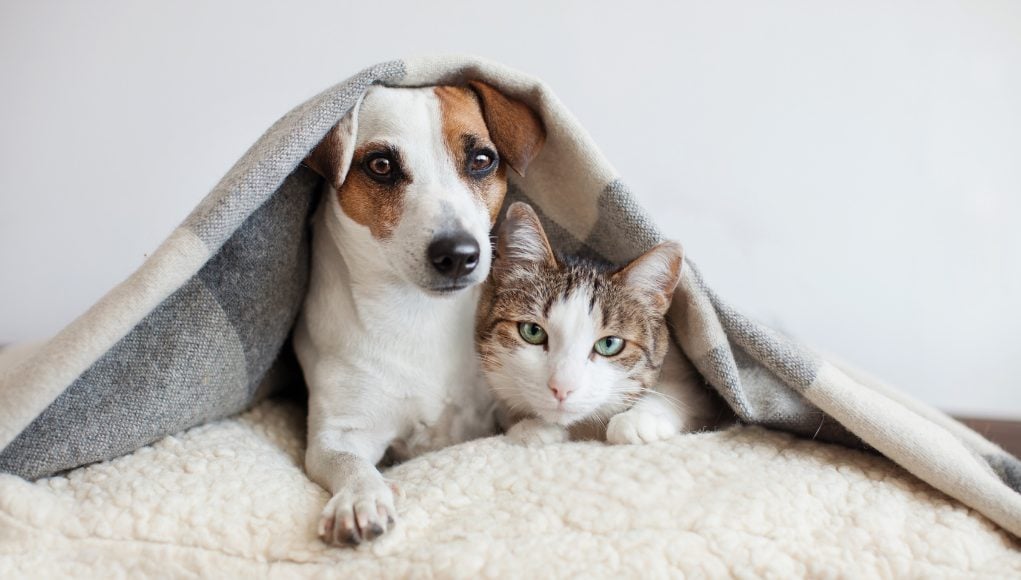To introduce a cat and dog to each other is no ordinary task.
Cats and dogs have a long-standing reputation as archenemies. They have an instinctive hostility towards each other, even with the presence of their humans around.
Characters in shows like CatDog, Tom and Jerry, and Garfield exhibit the perfect portrayal of the cat and dog relationship in real life.
Table of Contents
- Tip #1: Check Pet Compatibility
- Tip #2: Introduce Your Pet Slowly To Each Other
- Tip #3: Start With A Few Home Adjustments
- Tip #4: Use Tricks to Impose Familiarity
- Tip #5: Teach Your Pets Basic Commands
- Tip #6: Desensitize Your Pet As Soon As Possible
- Tip #7: Determine If It's Playtime Or Not
- Tip #8: Allow Them To Interact While Being Monitored
- Tip #9: Show Your Pets Equal Affection When Together
- Tip #10: Redirect Negative and Reward Good Behavior
- Tip #11: Separate Them While You're Gone
- Tip #12: Schedule Their Interactions
- Tip #13: Repeat these Daily
- Tip #14: Have Realistic Expectations
- Tip #15: Prepare A Backup Plan
- Conclusion
Despite this fact, cats and dogs can get along very well, too—you might even find them sticking to one another like glue. However, it will not be an easy task, primarily if one of your pets showcases signs of trauma seeing the other.
Here are essential tips to remember as you introduce a new pet to your cat or dog.
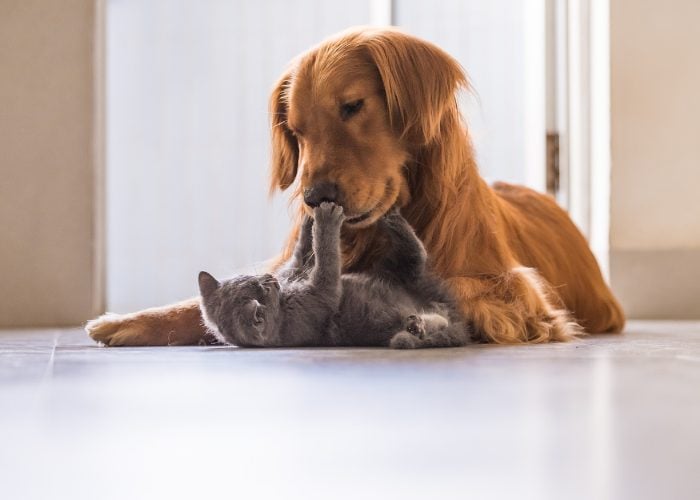
Tip #1: Check Pet Compatibility
Before partaking on a long journey as a feline and canine parent, you must think about the consequences of having both species in one place.
If you have an existing pet in your house, try to weigh in every factor that might affect them if you plan to add more.
Will they be able to adapt to it? Will they be comfortable about it? Or will they be the type to react aggressively to it?
However, if you've already decided to bring in two pets, it's best to pair them based on their age. The closer their ages are, the more comfortable they will be as they grow up.
Thus, if you have a kitten, try to pair them up with a puppy, and vice versa. The same thing goes for older pets.
There are still other things that you have to consider when it comes to this subject. But take it slow, and think thoroughly through it.
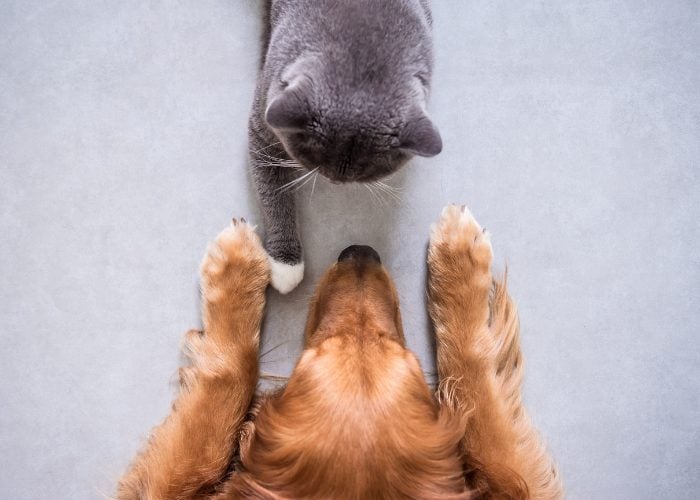
Tip #2: Introduce Your Pet Slowly To Each Other
If you're about to bring a new pet home, be aware that your present cat or dog might want to take the claim into their territory. Domestic animals are territorial; they might even fight to the death if they have to.
Introduce your new pet to your cat or dog in a way that they won't feel threatened by them. Move them away from where the latter usually stays, eats, or sleeps by keeping the new pet in a room where your cat or dog can't reach them.
Over time, as your old pet familiarizes with your new pet, they will peek with curiosity and will want to meet them, and vice versa.
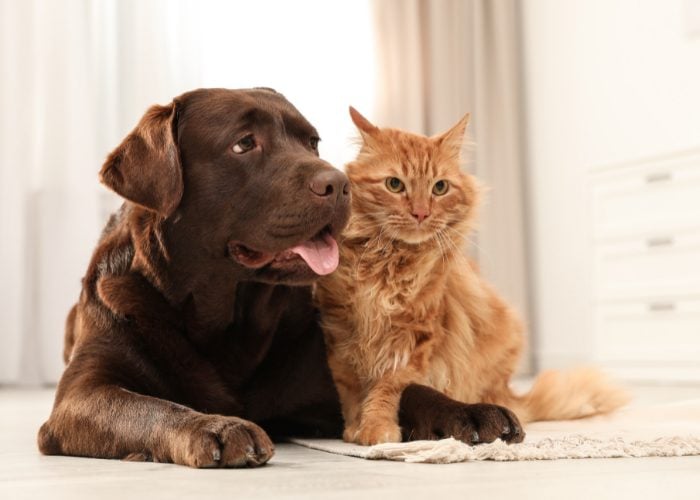
Tip #3: Start With A Few Home Adjustments
Cats and dogs are usually prone to stress, especially when exposed to pressure. Thus, as a responsible dog owner, you must prepare a private for each of your pets.
Since cats are more introverted, you can prepare small spaces to relax and have their own “me” time. This area can be cat walls, shelves, or perches since they are more into high spots.
On the other hand, dogs love to play out; thus, it would be best to have their play area in your backyard or somewhere near your house. Limit their playful tricks inside your home so they won't be able to disturb your cats.
Furthermore, you must also strictly impose on your pets not to disturb one another, especially when one is not in a good mood. Besides, to avoid fights, let them only interact if both parties are comfortable with it.
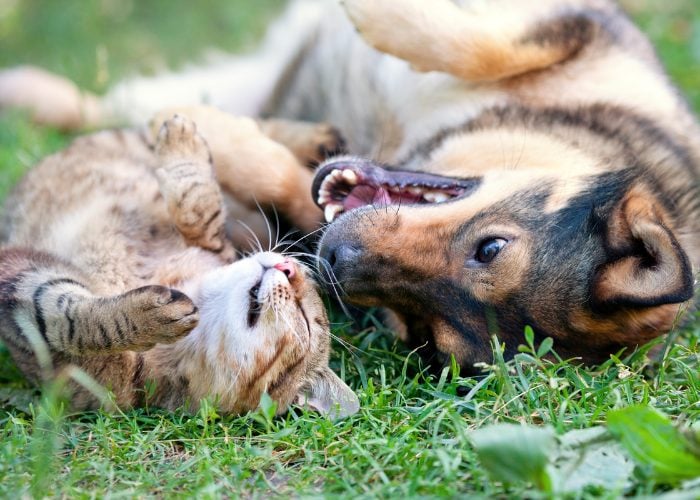
Tip #4: Use Tricks to Impose Familiarity
While humans use their sense of sight to identify other species, cats and dogs primarily rely on their scent receptors.
To use this feature, fetch some treats or goodies that you think both would like and place them on the opposite ends of a closed door or a table. As time passes, get their treats or goodies closer until they can see each other face to face.
This practice will teach them how to associate their scents with the food they're eating, which they consider pleasant. Besides, this exercise will also teach them how to cooperate and grow accustomed to each other's presence.
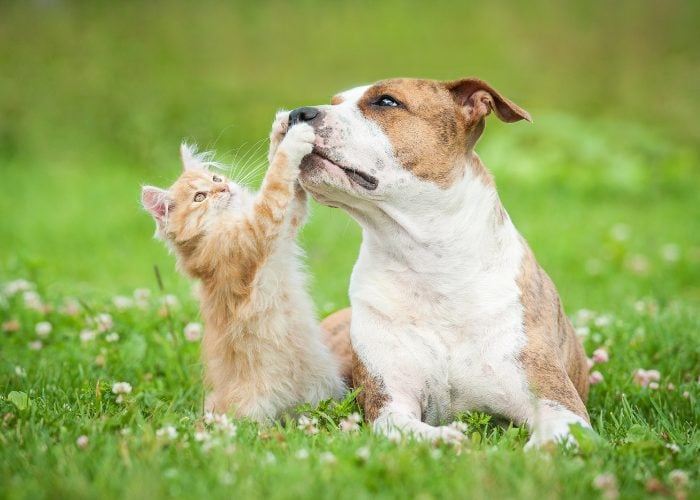
Tip #5: Teach Your Pets Basic Commands
When chaos ensues between cats and dogs, it's always the dogs who have started it because they have a higher prey drive than cats, even when domesticated.
Cats particularly hate it when dogs chase them around, especially the gigantic breeds. Aside from the fact that they're ten times bigger than cats, dogs are also faster at running.
These facts are the reason why you must teach your dog basic dog commands. Aside from the fact that this practice will teach your dog how to behave, it will also teach them how to be a responsible pet.
Teach and enforce obedience training on your dog and start with “sit,” “stay,” or “stop” commands. Make sure to communicate with your canine in a way that's easy for them to understand.
It is also best to teach your dog to stop provoking your cat. You may use “leave” or “leave it” as signals to leave the cat alone before a possible retaliation or harm happens to your dog.
You may also want to teach your cat how to get away from your dog without aggression by teaching them to run towards the nearest highest place they can climb up.
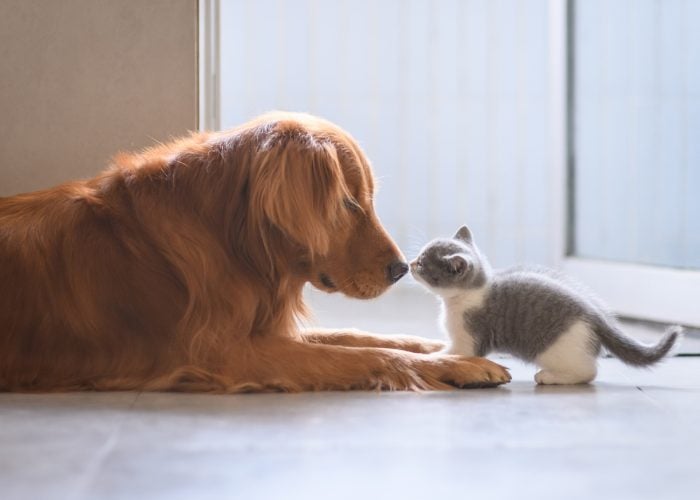
Tip #6: Desensitize Your Pet As Soon As Possible
On the other hand, desensitizing your dog means training your pet to ease themselves whenever they encounter another pet inside their vicinity. Have you noticed your dog overreacting whenever they see a cat?
They either become stressed, threatened, or overly excited. These reactions may make your pet challenging to interact with if this isn't corrected.
One way to desensitize your dog is by using a baby gate as a barricade. With the baby gate, they may familiarize themselves with other dogs or cats by simply seeing each other and smelling their scents from afar.
However, if your dog is hyper-fixated on your cat or vice versa, try to redirect their attention by distracting them with toys or treats and pairing it with a simple command. This practice will help them focus and be more attentive to their surroundings.
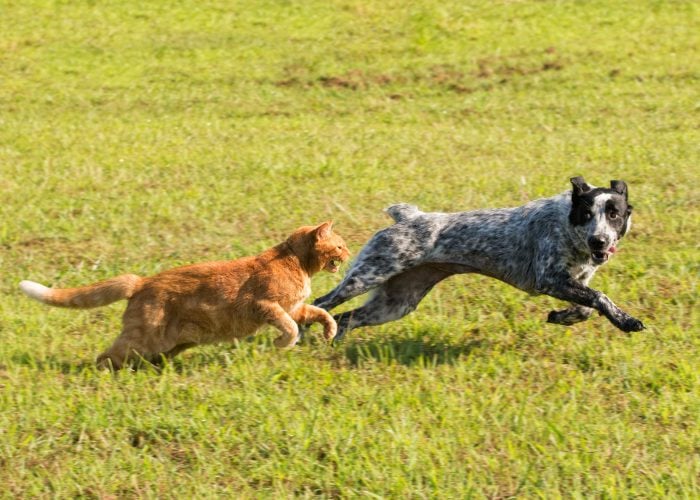
Tip #7: Determine If It's Playtime Or Not
Playtime for pets is their way to introduce, bond, and enhance their social skills. Playing also keeps them healthy while improving their overall balance and coordination, as well as keeping your pet's mind sharp and focused.
However, it's a common assumption that when a pet wants to play, the other pet likes to play with them as well. It's simply false.
For example, if your cat wants to play with your dog, you might immediately assume that your dog wants to play with them too. However, there is a 50/50 chance that the very same dog is very frustrated or tired to play along with your cat, or vice versa; thus, they will choose not to.
The tip here is to observe the playfulness level of your cat and dog for a few weeks. Determine if their playfulness is affected by their personality, moodiness, or health—or if they haven't adjusted well yet.
Separate them from each other if one of them gets too annoyed or tired that they might address it with aggression.
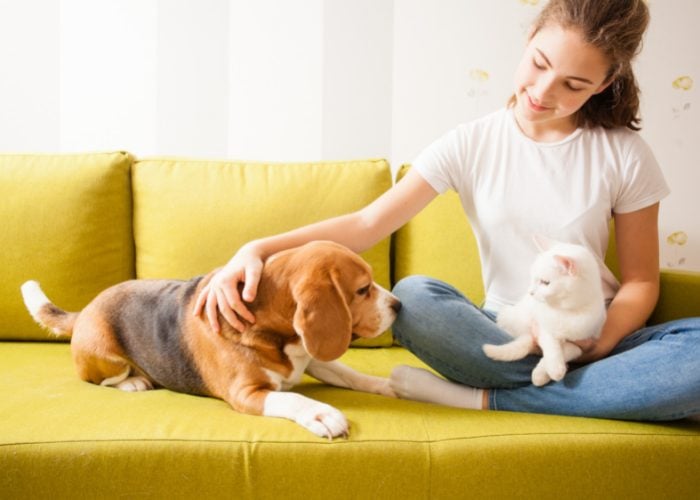
Tip #8: Allow Them To Interact While Being Monitored
If the animals do seem to get along well, don't hesitate to let them loose as long as you keep on watching them.
Whether they are playing indoors or outdoors, attach a leash to your dog's collar. You must do this so you can step on it and gain control of your puppy if you sense aggression.
If tension occurs, separate them and do not hesitate to introduce and put a barrier between the two animals to avoid further conflicts.
Although it's pretty risky, as a responsible dog owner, you have to make sure that none of your pets will get harmed while playing. Thus, it's essential to take the role of being in charge of them.
Ensure that the cat and the dog can access their safe spots to chill out, especially when they feel stressed. Otherwise, you might not want to see a mess they might make due to frustration and pent-up aggression.
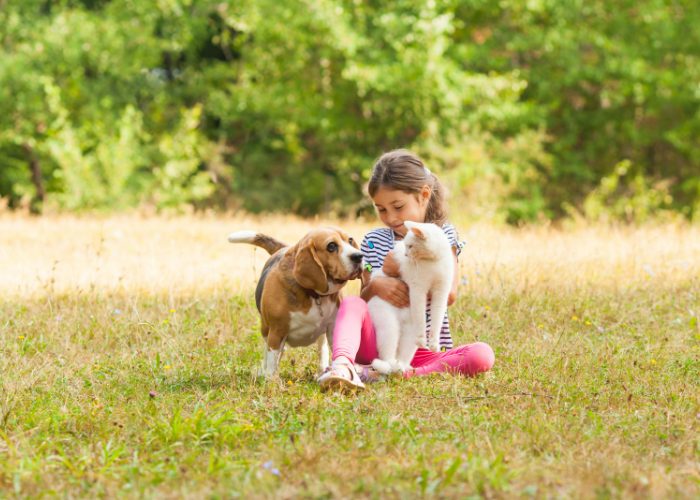
Tip #9: Show Your Pets Equal Affection When Together
When introducing your pets to each other, don't show favoritism on one pet over the other.
Every time they introduce and interact, proceed to give them affection and head pat equally. This practice is to avoid any potential aggression due to jealousy that may happen.
Thus, every time one comes near, always call the other. This method will also be a sort of bonding with you and your pets and a chance to get them closer.
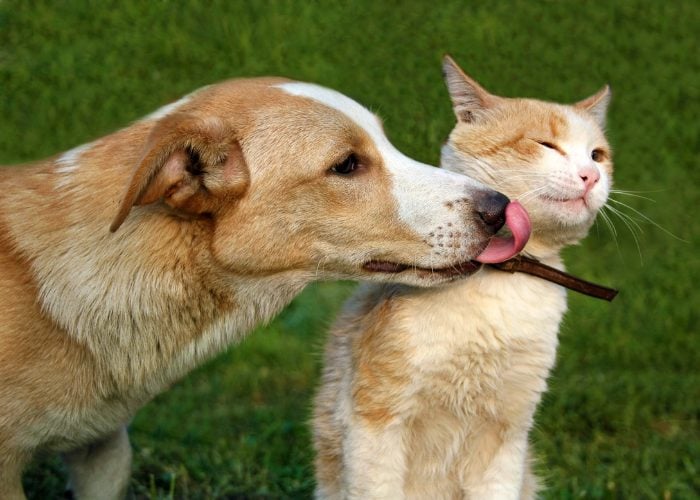
Tip #10: Redirect Negative and Reward Good Behavior
Suppose your pet shows any rough actions or behavior that may harm your other pet. In that case, you have to stop them immediately and give the afflicted pet any other activity that will divert their attention from the other.
In contrast, if your pet exhibits good behavior towards the other or vice versa, do not hesitate to reward them quickly. This practice will help your dogs or cats associate something positive with that interaction; thus, there's a high chance that they will do it again next time.
These things may take a lot of time and training, but they will be worth it in the end.
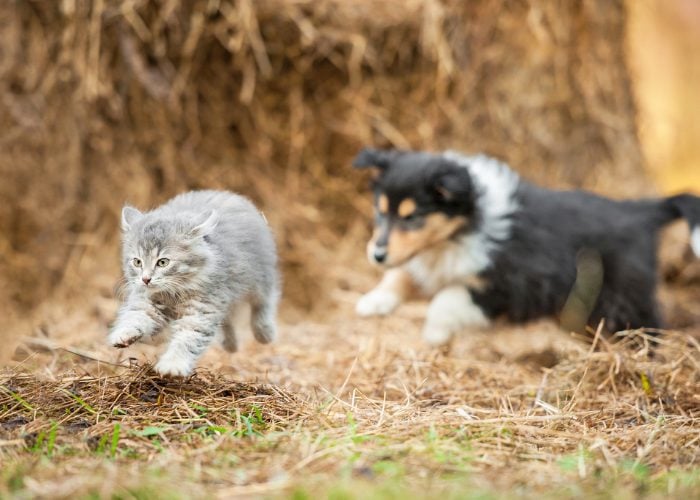
Tip #11: Separate Them While You're Gone
Do not, and I emphasize, do not trust your pets in keeping each other company if you're gone, especially if they're still not comfortable with each other.
Pets are like jealous toddlers when a newcomer is at home. Thus, while you're gone, they might grab this as a chance to become hostile to your new pet, who, in return, will see them as a threat.
The outcome won't be as pretty as you think it would be. Hence, you must not force your pets to interact on their terms because it will only be unfavorable for both parties, and you wouldn't want that.
Therefore, if you're out to buy some groceries or to fetch your kid from school, try to separate them as much as you can.
Make sure that they won't have access to each other, too. You can do this using a baby gate or any improvised material you have at home.
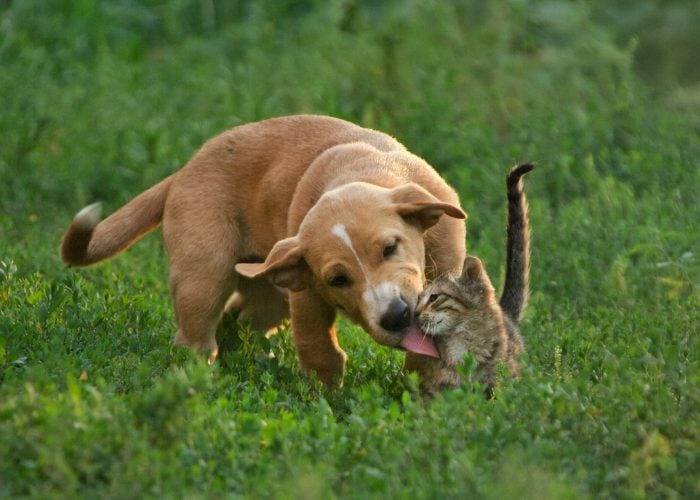
Tip #12: Schedule Their Interactions
You may spice their familiarization up by scheduling their interactions and noting what problems are still present. You may use the tips mentioned above for future references.
When it's time for them to interact and introduce themselves together, don't forget to bring their favorite treats. Every time they cooperate and complete a trick or a game successfully, reward them.
However, if one of them wants to leave the room, let them do so; they'll come back themselves. If this happens, don't let the other catch up to them; they might want their own space for a while.
Try to keep their sessions short and sweet; end them before one of your pets suddenly feels competitive or aggressive.
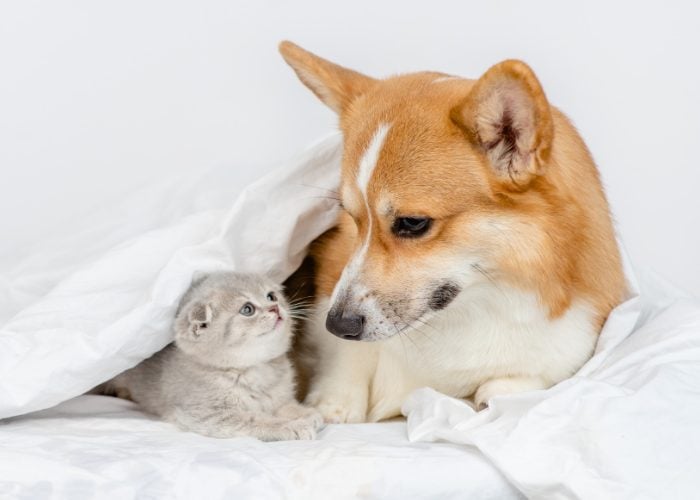
Tip #13: Repeat these Daily
After having your pets familiarize themselves with each other, you must now repeat these sessions daily so that they can grow closer.
They can go together on morning walks, or you can give them their treats together.
They may also have their nap time together and playtime to not get jealous of the other.
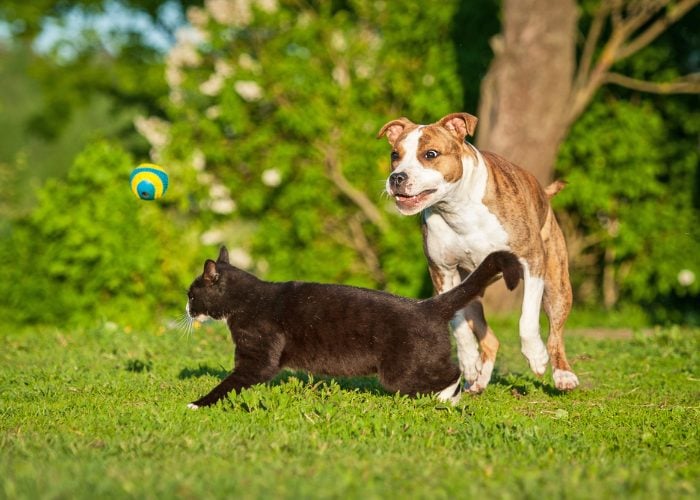
Tip #14: Have Realistic Expectations
Realistically speaking, if your pet hasn't interacted or lived with any other pet besides themselves, they might become wary. Your pet might either see the new pet as prey or a new playmate.
Do not expect that they'll immediately be comfortable with each other. Thus, it would help if you encourage your pets to take baby steps when interacting.
Tip #15: Prepare A Backup Plan
If things do not go well as you expect, always carry out many backup plans as much as you can. Your pets can do these tricks without the danger of having to interact face-to-face.
Dogs and cats have a very keen sense of smell, and you may use this as a trick to let them identify each other.
One example is by swapping some toys they use for playtime. Doing this makes it easier for them to identify their scent, especially when they smell each other's saliva.
Another trick you can use is switching their beddings until they become familiar with each other's scents. You may also rub two different fabrics on both of them. Leave the said fabric with the cat's scent on the dog, and vice versa.
Do this until your cat and dog no longer react to the smell.
Conclusion
Cats and dogs don't have the same body language; as a result, miscommunication happens. Although chaos occurs with these two, they can be friends in no time—requiring long patience to introduce on your part.
There may be instances where they become wary of each other even if you introduce them, which can be risky. It's better to keep an eye on them, just in case a possible fight would likely occur.
Carefully take the tips mentioned above in introducing your pets to one another but make sure to break it to them gently.
READ NEXT: How to Introduce Dogs to Your Chickens: A Step-by-Step Guide


